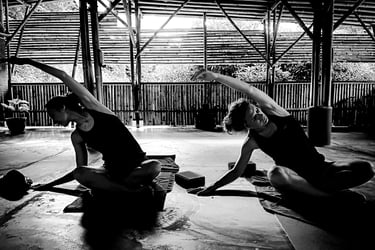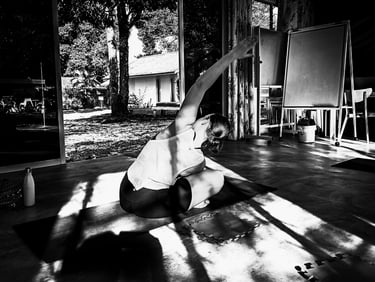Seated Side Bends : Unfolding Insights
The Diagnostic Power of a Seated Side Bend
Uneven Reach: Does one hand slide significantly further than the other? This can indicate lateral trunk asymmetry, perhaps due to tight obliques or rib cage restrictions. It may also reflect uneven hamstring flexibility or hip rotation that limits one side more than the other.
Trunk Rotation: Are you able to maintain pure lateral flexion, or does the torso rotate forward or backward? This compensation may signal thoracic stiffness or an attempt to bypass tightness in the side body—both of which can feed into lower back discomfort.
Lifted Sit Bone and Uneven Knees: A lifted sit bone or noticeable difference in knee height often points to pelvic imbalances. These may stem from tight hip flexors or rotators, functional leg length discrepancies, sacroiliac joint issues, or general muscular asymmetry around the pelvis—all common contributors to lower back pain.
This is particularly revealing among desk workers, whose prolonged seated posture often masks these imbalances until they attempt a movement outside their habitual range. The side bend gently exposes asymmetries that daily sitting tends to conceal.
For those tentatively stepping onto a yoga mat, the world of asana can feel complex and demanding. Yet within the simplicity of seated postures lies a gentle gateway—one that offers accessibility to beginners and deep insight into the body's mechanics. Among these foundational shapes, the seated side bend stands out as a particularly valuable tool. It introduces spinal mobility with grace and, perhaps surprisingly, offers a window into the root causes of lower back pain and underlying hip imbalances.
Lower back pain is a pervasive issue, often arising from a subtle interplay of factors—tight hamstrings, limited hip mobility, and pelvic asymmetries among them. And while the seated side bend may appear straightforward, it can illuminate these very imbalances with clarity. When performed with awareness, the pose becomes not only therapeutic but also diagnostic, revealing habitual patterns that may be fuelling discomfort.
Beyond musculoskeletal cues, the seated side bend also reveals how breath moves through the body. The compressed side may feel restricted, prompting breath-holding or shallow breathing—patterns that often accompany, and can intensify, chronic tension. The breath in this posture can uncover these tendencies, offering yet another entry point for therapeutic intervention.
Easing Lower Back Pain Through Side Bends
While the seated side bend offers diagnostic value, it is also an accessible and effective pose for managing lower back pain. Its benefits include:
Lengthening the Lateral Trunk: Gently stretches the muscles along the torso’s side, which can become habitually tight and contribute to stiffness.
Creating Space in the Rib Cage: Enhances breath capacity and reduces upper body tension, indirectly relieving strain on the lower back.
Encouraging Hip Mobility: Depending on the variation, seated side bends may stimulate subtle movement in the hips, addressing tightness that tugs on the pelvis.
Cultivating Body Awareness: The focused nature of the pose invites students to tune into sensation, developing interoception and insight into their own movement patterns.
By beginning with supportive, low-strain poses like the seated side bend, students can gently develop flexibility, stability, and awareness—foundational elements in the journey to long-term relief.
In Closing
The seated side bend is far more than a basic stretch. It is an accessible and powerful introduction to yoga, rich with diagnostic potential and therapeutic benefit. For those managing lower back pain, it offers a safe and insightful entry point, reminding us that meaningful progress often begins with the simplest of movements.




More Insights
